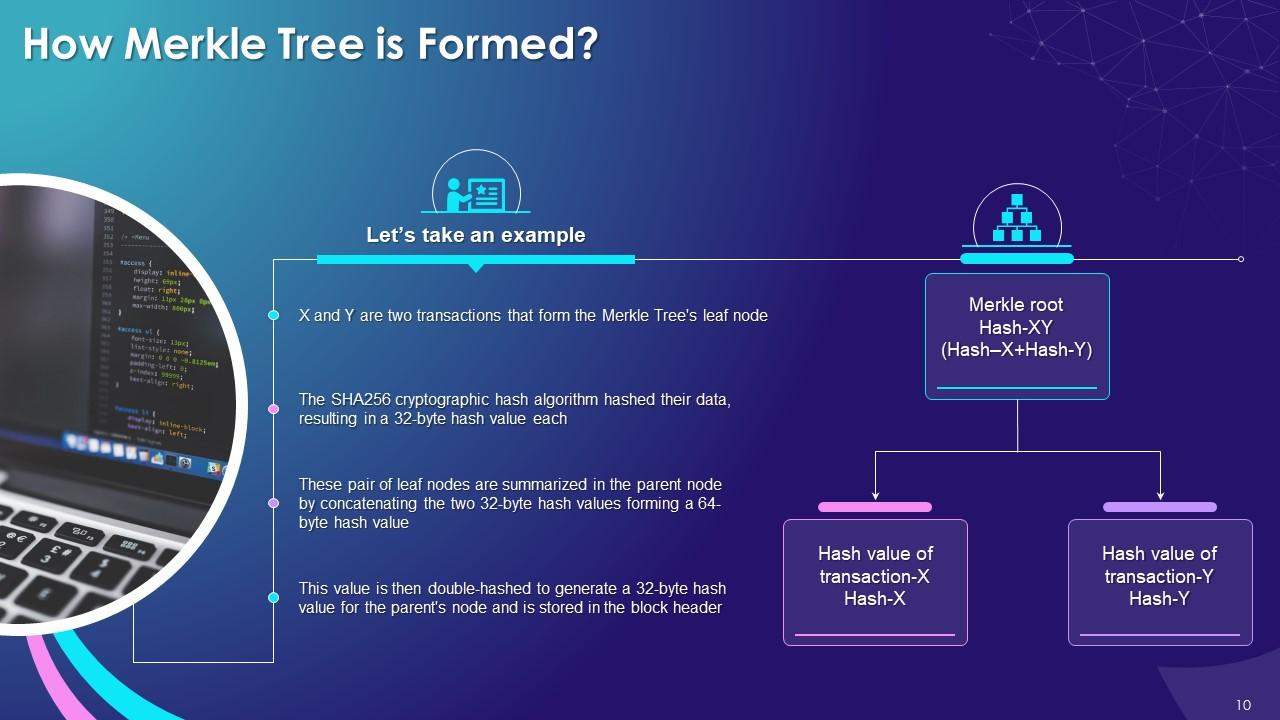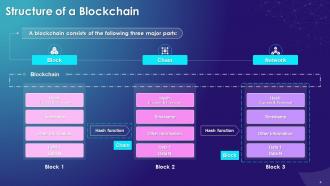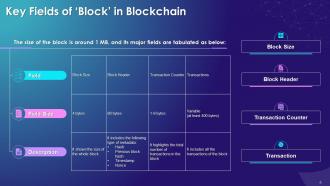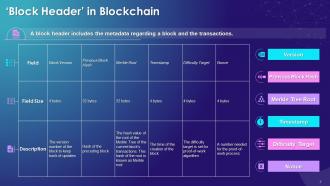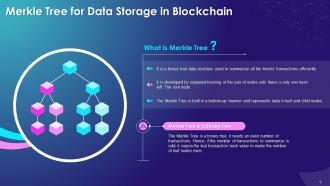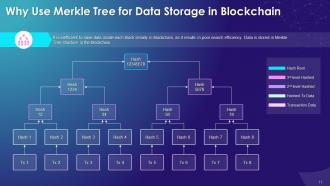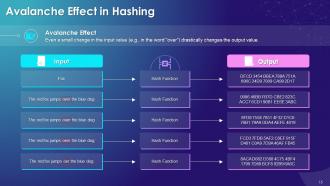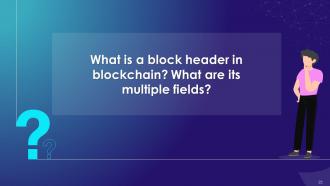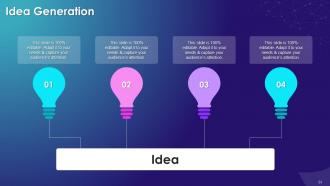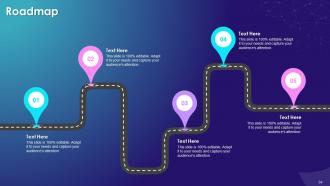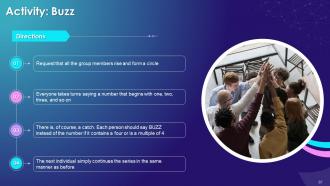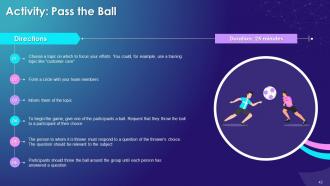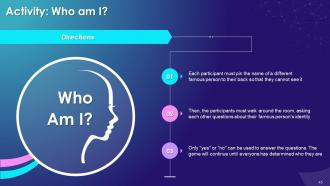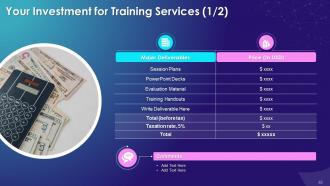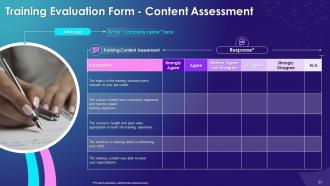Key Blockchain Components Training Module on Blockchain Technology and its Applications Training Ppt
This PPT training deck covers the technical concepts of blockchain technology, such as blockchain elements block, chain, and network, block fields block size, block header, transaction counter, transactions, and block header fields previous block hash, Merkle root, timestamp, difficulty target, and nonce. It also contains details on the Merkle Tree formation and its useability for data storage in the blockchain. The PPT module covers hashing in the blockchain and characteristics of hash functions deterministic, quick computation, pre-image resistance, randomized, and collision resistant and avalanche effect. It also includes slides on types of hash functions secure hashing algorithm, race integrity primitives evaluation message digest RIPEMD, message digest algorithm 5, and blake2. Further, it contains key takeaways, discussion, and multiple-choice questions related to the topic to make the training session interactive. The PPT deck also includes additional slides on about us, vision, mission, goal, 30-60-90 days plan, timeline, roadmap, training completion certificate, energizer activities, detailed client proposal, and training assessment form.
You must be logged in to download this presentation.
 Impress your
Impress your audience
Editable
of Time
PowerPoint presentation slides
Presenting Training Session on Key Blockchain Components. This deck comprises of 82 slides. Each slide is well crafted and designed by our PowerPoint experts. This PPT presentation is thoroughly researched by the experts and every slide consists of an appropriate content. All slides are customizable. You can add or delete the content as per your need. Not just this, you can also make the required changes in the charts and graphs. Download this professionally designed business presentation, add your content and present it with confidence.
People who downloaded this PowerPoint presentation also viewed the following :
Content of this Powerpoint Presentation
Slide 4
This slide provides an overview of the structure of blockchain, covering the key components such as block, chain, and network.
Instructor’s Notes:
The structure of blockchain is similar to that of linked lists or binary trees in which the linking is done using pointers that point to the previous or next list element on the nodes in the linked list.
The three major parts of blockchain are:
- Block: It contains the list of transactions recorded into a ledger over a time period. For every blockchain, the size, period, and triggering event varies
- Chain: Chain is a hash that glues multiple blocks together in the blockchain and enables trust creation. In the blockchain, the SHA-256 (Secure Hash Algorithm) hashing algorithm is primarily used
- Distributed Network: The network consists of multiple nodes across the globe to achieve the decentralized structure of the blockchain. Each node will contain the complete record of all transactions which have been carried out in the blockchain
Slide 5
The purpose of this slide is to highlight the key components of a block in the blockchain, which are data, hash, and previous hash. The slide also includes details of timestamp and genesis block.
Instructor’s Notes:
The key components of a block in blockchain are as follows:
- Data: The record of all the transactions. Each block of a blockchain can contain thousands of transaction data. The type of data stored depends upon the use case of blockchain
- Hash: The hash is like a block fingerprint as it helps identify the block and its content. A hash is always unique for each block
- Previous Hash: As the name suggests, it contains the hash information of the preceding block. Its primary function is to create the chain of blocks and make blockchain secure
- Genesis Block: The first block created for any blockchain with the previous hash as “0” is the genesis block
- Timestamp: A timestamp is a date-time value that is stored in a block. It provides information about the time when the block was created. In the blockchain, this value is in the form of a Unix timestamp format
Slide 6
This slide represents the key fields of block in blockchain such as block header, block size, transaction counter and transactions. It also contains information pertaining to field size and content description.
Slide 7
This slide includes the segments of block header such as block version, previous block hash, Merkle root, timestamp, nonce, and difficulty target.
Slide 9
This slide showcases information about the definition of the Merkle Tree and why it is called a binary tree.
Slide 10
This slide provides information about the creation of Merkle Tree in blockchain to summarize all the blocks' transactions efficiently.
Slide 11
This slide visually showcases the Merkle Tree for blockchain. It also includes information about why Merkle Tree is used to store data in the blockchain.
Slide 13
This slide provides information regarding the concept of hashing in blockchain technology. It also includes details regarding the hash value and an example to illustrate it.
Slide 14
The purpose of this slide is to highlight the multiple properties of cryptographic hash functions, which are deterministic, quick computation, pre-image resistance, different hashes for different input (randomized), and collision-resistant.
Instructor’s Notes:
The key characteristics of cryptographic hash functions are as follows:
- Deterministic: A hash function will always give the same output for the same input. It is a vital characteristic because if a hash function gives a different value each time for the same input, it will be impossible to keep track of inputs
- Quick Computation: A hash function must return the hash value for input quickly to ensure the high efficiency of the blockchain system
- Pre-Image Resistance: A hash function is hard to invert so that it becomes infeasible to determine the original input from a hash value
- Hash Value Changes with Minute Change in Input: Even a minute input drastically alters the hash value
- Collision Resistant: Two different inputs will never have the same unique hash value
Slide 15
This slide visually presents the hashing's avalanche effect, showcasing how minor input value change drastically alters output value.
Slide 16
The slide includes an example to highlight the avalanche concept in the blockchain.
Slide 17
This slide highlights the major classes of cryptographic hash functions such as secure hashing algorithm (SHA-2 and SHA-3), RACE integrity primitives evaluation message digest (RIPEMD), message digest algorithm 5 (MD5), and BLAKE2.
Instructor’s Notes:
- Each hash function category has multiple algorithms
- For example, SHA-2 hash functions types include SHA-224, SHA-256, SHA-384, SHA-512, SHA-512/224, and SHA-512/256
- Although all of these hash functions are similar, they differ slightly in the way the algorithm creates output for the input in terms of fixed length
- SHA-256 is perhaps the most famous of all cryptographic hash functions because it’s used extensively in blockchain technology. Also, Satoshi Nakamoto used it in the original bitcoin protocol
Slide 18
This slide tabulates the comparison of multiple cryptographic hash functions used in the blockchain on multiple parameters such as output size (bits), internal state size, block size, length size, word size, and rounds.
Slide 20
This slide depicts the summary of the key blockchain components training session. The trainer can use it to highlight the essential concepts of the session to trainees.
Slide 37 to 51
These slides contain energizer activities to engage the audience of the training session.
Slide 53 to 79
These slides contain a training proposal covering what the company providing corporate training can accomplish for the client.
Slide 80 to 82
These slides include a training evaluation form for instructor, content and course assessment.
Key Blockchain Components Training Module on Blockchain Technology and its Applications Training Ppt with all 87 slides:
Use our Key Blockchain Components Training Module on Blockchain Technology and its Applications Training Ppt to effectively help you save your valuable time. They are readymade to fit into any presentation structure.
-
Amazing product with appealing content and design.
-
Loved the templates on SlideTeam, I believe I have found the go to place for my presentation needs!












